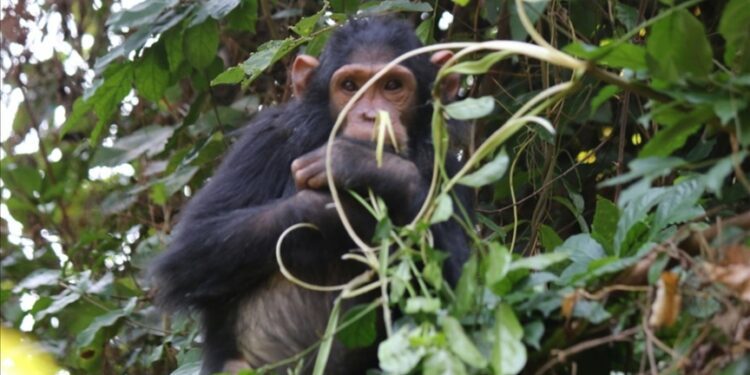– Population of chimpanzees in Gombe National Park has declined to 90 from around 150 in 1960s
– Threats to the chimpanzees range from habitat loss to increasing conflict with humans and disease outbreaks
– ‘These chimpanzees are a vital part of our natural heritage and we can’t afford to lose them,’ says Simula Maijo, a senior researcher at the Tanzania Wildlife Research Institute
KIGOMA, Tanzania
One of the world’s most famous chimpanzee colonies is facing an existential threat, a researcher has warned, calling for urgent steps to address the issue.
From around 150 chimpanzees in the 1960s, the total population in Gombe National Park in western Tanzania has dwindled down to around 90, according to conservationists.
These chimpanzees were the ones studied by legendary primatologist Jane Goodall, whose research offered invaluable insights into human evolution and behavior.
Their habitat on the shores of Lake Tanganyika has been steadily falling prey to agricultural expansion, while the animals also face risks such as poaching and diseases.
“It’s heartbreaking to see the destruction of the forest and these chimpanzees struggling the way they are today,” Simula Maijo, a senior researcher at the Tanzania Wildlife Research Institute (TAWIRI), told Anadolu.
“Each tree cut down means a loss of food and shelter for these apes.”
In Gombe National Park, located some 16 kilometers (10 miles) north of the city of Kigoma, there are no perimeter fences, allowing the chimpanzees to freely roam through the winding corridors of the forest.
These corridors connected various chimpanzee colonies in the park, but they have rapidly disappeared over past years, isolating the animals and reducing their genetic diversity, Maijo explained.
For the depleting forest area, he cited charcoal production and timber extraction as primary factors, along with “smallholder farming that has transformed the corridors into fragmented patches.”
That has increased human and wildlife conflicts, another reason for the declining numbers, while also exacerbating the risk of disease outbreaks, he added.
‘We must act now’
As you travel toward to Gombe from Kigoma, the evidence of forest destruction is glaring.
Sacks of charcoal line the road and swaths of land have been cleared for farming. Cassava and oil palms dominate the landscape, the latter being a major contributor to habitat loss.
“We must act now to protect these incredible creatures before it’s too late,” said Maijo, stressing that their survival is “linked with the health of our environment and, consequently, our own well-being.”
Conservationists are relying on a multifaceted approach to protect the chimpanzees, with one key part of the strategy being restoration of the forest corridor.
By replanting native trees, they aim to reconnect the fragmented habitats, allowing the chimpanzees to move freely and find new mates, boosting genetic diversity.
“Restoring these corridors is vital for the long-term survival of Gombe’s chimps,” said Livingstone Paul, a local conservationist in Kigoma.
“Tree planting and ecosystem restoration is critical for the survival of the chimpanzees.”
Another initiative involves creating land-use plans for villages around the park, with researchers utilizing satellite imagery to map the area and engaging villagers to identify land for settlements, grazing and conservation.
This joint effort led to the establishment of village forest reserves, and of more than 100 villages around Gombe, about 70 have set aside land for conservation.
“By involving local communities, we have created a network of guardians for the chimps,” said Sofia Jamali, a community leader.
“Many people have adopted better farming methods to reduce tree cutting and discourage poaching.”
‘Part of our heritage’
Researchers are also using a comprehensive health surveillance system, including regular veterinary checkups and disease monitoring for early detection and intervention.
“Early intervention can mean the difference between life and death,” Yohanna Manumbu, a poacher-turned-conservationist, told Anadolu.
“I had no idea how important these apes were until I got involved in conservation work. They’re part of our heritage, and we need to protect them for future generations.”
Maijo echoed the same views, stressing the importance of Gombe’s chimpanzee population as “a vital part of our planet’s biodiversity and a link to our own evolutionary past.”
“We need the world to understand what’s at stake. These chimpanzees are an integral part of our natural heritage and we can’t afford to lose them,” he said.
“It’s crucial that we protect them, not only for our environment and economy, but also for the benefit of future generations.”






